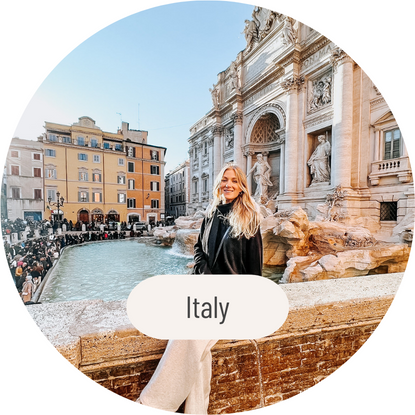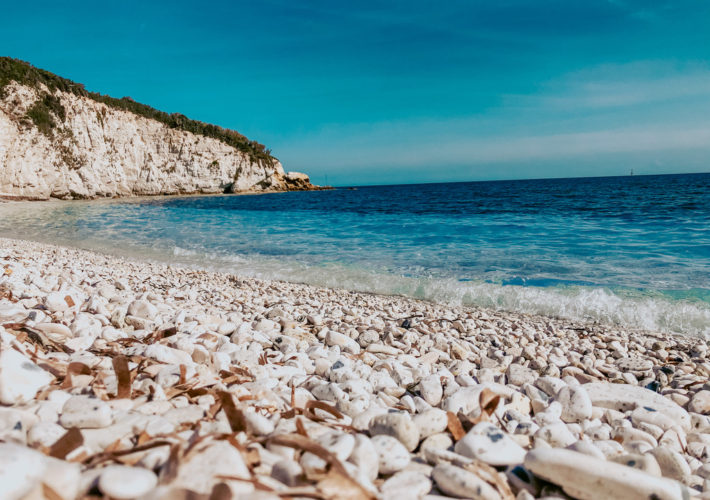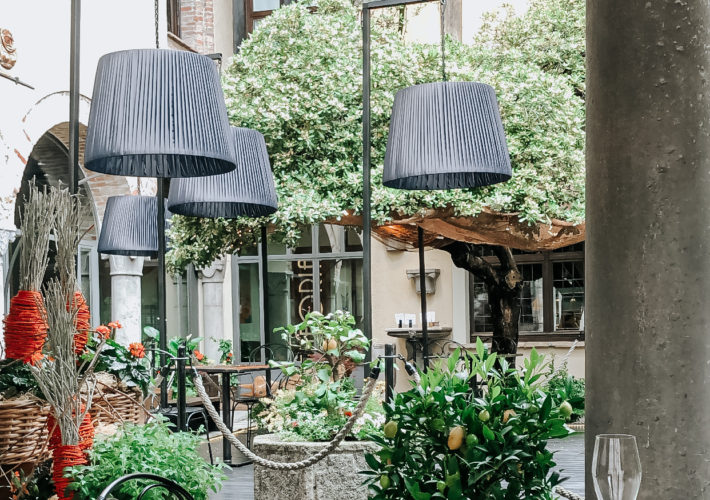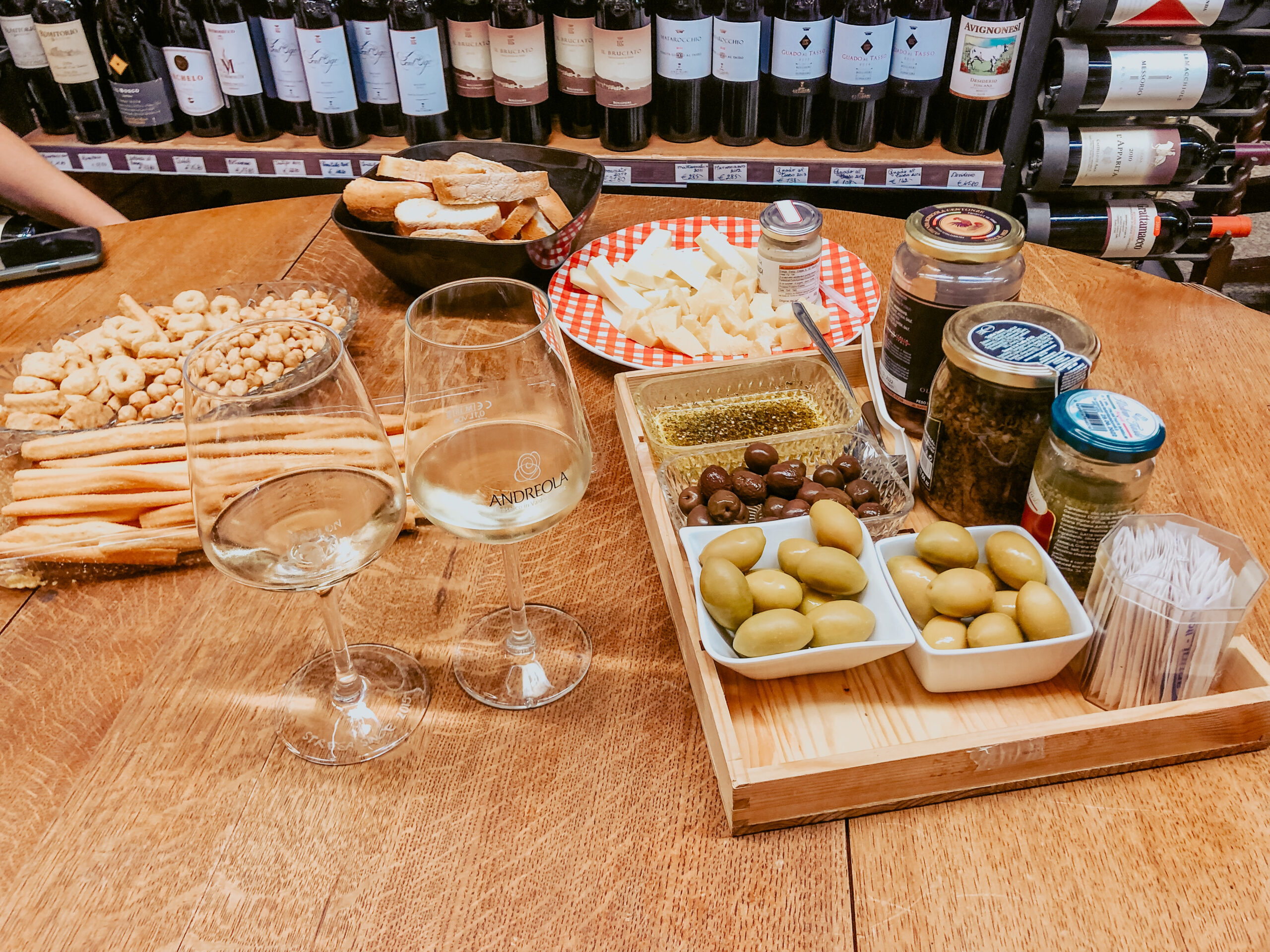Traveling in Italy is the ultimate experience. Home to simplicity and slow living, you will begin to see the essence of live-work balance. Whether you have a cappuccino in the morning, a lunch on a beautiful terrace, or an authentic dinner and wine with friends, you will find the pace of Italy much more relaxed than any other location.
Food in Italy
Pasta! Pizza! Bread! Cheese! Wine! Pastries! Coffee!! Each region in Italy is known for their own specialty foods. If you are traveling between regions I highly suggest you acquaint yourself with what foods and ingredients the region is known for. Italians make fresh food every day from simple recipes and seasonal ingredients to create incredible flavors.
Without GMOs, chemicals, and preservatives, food can grown more organically and naturally which is why you don’t feel super bloated and groggy after eating full meals in Italy. Eating fresh, local foods by the season is also a big priority in Italy. Because Italians only use seasonal foods, many restaurants continuously rotate their menu items to compliment the season’s ingredients.
Reservations
Yes, you must book reservations in advance, especially dinners on weekend nights during the summer. Once you have a reservation, unless stated up front beforehand, your reservation is yours for the night. You will never be rushed when dining in Italy because the service industry here does not work on tips. The same also applies for the restaurant, if you are in a hurry, maybe consider grabbing food from a bakery, deli, or bar. If you don’t have at least 1.5 full hours, don’t rush the restaurant.
Food Sensitivities
Italy is very progressive in accommodating persons with food intolerances. You will find that many restaurants list food allergies and sensitivities for their entire menu. They are very good at providing customers with an ingredients list outlining any meals that might pertain food allergies and intolerances on their menus. You can find nearly any product in Italy without gluten. Although many people would assume their pastas, risottos, breads, etc come with gluten (as some do), there are also many flours that don’t have gluten…making gluten free options easily attainable.
If you have any food sensitives/intolerances, or become pregnant, it is very easy to work around your food restrictions while traveling in Italy, so don’t be scared! You will need to let your servers know up front what your requirements are so they can provide a safe and enjoyable meal.
Ordering in Italy
When ordering in Italy, the table orders all dishes, besides dessert, up front. When the server comes to your table, you’ll go around in a circle and list each course, in the correct order (antipasti, primi, secondo). Antipasti = appetizer. Primi = first. Secondo = second. Dolce = dessert. Digestif = digestive (liqueur). It is normal to have something light for an appetizer, followed by a pasta as a primi, having a fish or meat as a second, and finishing with a dessert.
The portions in Italy are relatively small for each course and it is ideal to eat over a period of courses. The kitchens will only cook the next course after you have finished the one before it. This is one reason why Italian lunches and dinners run hours long.
After you’ve finished the first 3 courses, the server will ask if you would like a coffee and/or a digestif. If it’s your first time, I suggest you try both. You can always ask for a decaf coffee and a local digestif. I prefer Amaro del capo, Braulio, and Rucolino (depending on what’s available).
When you are ready to order, shut the menu! This is a clear sign to the servers that you are ready to order and can offer faster service.
Pro Tip!
International Norms
And please, do not flag a server down to tell them you’re ready to order. They will arrive to you when they are free, and no, they aren’t avoiding you (in case you’re someone who loves to take to TripAdvisor your vengeful review based on an American service industry standard…oops, did I just go there? There’s nothing more annoying than traveling to a new country and expecting everything to be the same as back home…side eye).
Ordering water is a special instance where you might need to request another bottle after you finish the first. Water costs money…free refills are not a thing. If you want free water you can ask for tap. So if you need another bottle of water, just ask. The same goes for a glass of wine…if you order a glass, the waiter will think you only want a glass and will assume you don’t want another…so you may need to ask for another. Or, consider ordering a half bottle if you know you won’t drink a full bottle but also want more than a glass – just something to keep in mind.
When to order frizzante? I am a big fan of ordering frizzante water when I know I’m not drinking alcohol…the bubbles really help give it a lil extra somethin’ extra. Another great time to order frizzante is when you are at a wine tasting. The frizzante water can be somewhat a pallet cleanser (in my opinion)! Check out my Sober Travel page for more helpful tips when planning/traveling alcohol free.
Italian Language
There is a big difference in the pronunciation of the Italian language…especially between the North and South dialects. Wherever you go in Italy, I suggest you try to speak Italian to the workers at restaurants and hotels. They always appreciate it and will try to help you learn. I have also learned from personal experience that the more you try to converse with Italians in Italian, the better experience you might have with them.
The benefits I have seen from this include: a table with a nicer view, faster service, shorter wait times, etc. Also if you know futbol it can be a good idea to chat with them about the team of their region (so long as they’re doing well lol).
Some simple phrases you should know when you are visiting Italy:
“Posso avere una prenotazione per stasera?” = Can I have a reservation for tonight?
“Avete un tavolo per due persone?” = Do you have a table for 2 people?
Transportation in Italy
Public transportation is a major resource for Italians and travelers. In large cities you will use the train, metro, bus, and tram exponentially.
One thing to note about trains in Italy is that the AC is not very efficient. It gets very hot in the summer and high season, so it is vital you bring a handheld or electronic fan.
It is also a good idea to get on the train as early as you can because the luggage space is limited. If you are looking at the time table, the train platform (binario) will show within 10-15 minutes of train departure – but no earlier than that (unless the train has arrived early, in that case it will show).
Train strikes happen often in Italy. If a train strike occurs, your train will be cancelled completely. If you didn’t book a flexible ticket, there is really nothing you can do…it’s one of those things that just happens every now and then and it’s really annoying.
In order to prevent complete disruption to your travel plans, consider purchasing flexible tickets when booking so you can get some sort of refund or compensation. And don’t book the last train out at night or you might get stuck in whatever town you’re in (we know from experience). The only train times that will remain running on days of a train strike are between the morning and afternoon hours when people are on their way to/from work.
Train
The Trainline app is one of my favorite ways to search for train schedules and pricing. It will also track your journey in real time. You must buy tickets before your train departs because the control officer will come around to check if you have purchased tickets and sitting in the correct seat/carriage.
If you haven’t purchased tickets when the officer arrives, you will either receive a citation and be required to purchase a new ticket on the spot, or, the officer can escort you off the train at the next station and give you a citation. If you are traveling on a longer route like Milan to Florence, Florence to Rome, etc., you will likely be on a national train. The ticket options on these trains include Business Class, First, and General. My favorite companies to book with are Italo and Frecciarossa, in that order.
Business Class Tickets
Business Class seating has two sections…Business Executive Club, which has a private room with a door for a group of 4, and regular Business. I have seen families with older children or business professionals use the Executive Club room. Something to consider if you are traveling with small children, the Business Class carriages are generally a silent zone.
If you have a hangover from the night before (or you plan to drink a lot), the Business Class silent area is totally worth it!
Pro Tip!
The seating in Business has the largest chairs and the longest leg extension. Because these seats are the largest, very few seats are available. If you book Club tickets you will also receive Club lounge access in the train station.
This is a good option if you have an hour + wait time between trains. The Club lounge consists of reserved seating with free pastries and small drinks. You can also purchase access to the Club lounge separately with any train ticket. This is a good idea for anyone who wants to sit during the layover. The train stations throughout Italy do not have open seating and it can be hard to find seating in one of the small cafes within the train station, especially in high season.
First Class Tickets
If Business Club doesn’t work for you, try First class. First class is a great option if you prefer reserved seating and food & beverage service. The seats in First class are large leather chairs with extension options. They are more comfortable than General seating but smaller in size than Business. First class doesn’t feel crammed like General seating and there is a dedicated luggage space for First class travelers.
General Tickets
General seating will sometimes allow you to reserve your seats when purchasing, but not always, and you must pay for food and drinks at the train bar. All trains have vending machines on board as well. General tickets are a good option if you are taking shorter trips, you’re looking for affordable options, or you have multiple train changes.
As for the local or regional trains, all seating options are first come first served. Some newer trains may have charging ports, but not all.
Bus/Tram
Busses in Italy may run differently depending on what region you are in. Generally, you can buy bus tickets per trip, in bulk, or as a seasonal pass. Other times, you will pay to enter the bus with cash only. Once you’ve purchased your bus ticket (at the local bus ticketing office or at certain bus stations), you will validate your ticket once you enter the bus. You will see the honor system applies for many bus/tram options. At times the bus driver will check if you have a ticket or a bus pass and sometimes a control officer will be at a station to check as well.
The bus and tram transportation is the cheapest out of all the transportation options. Airport bus shuttles are always available on a routine schedule and will take you from the airport to the train station and/or city center. It is an affordable option rather than booking a private driver ahead of time, or a taxi. If you need an airport bus transfer into/from town, look for signs with “Autobus”.
Metro
The metro in Italy is key to getting around a large city like Milan, quickly. However, the metro is not available in every city. If it is, I suggest using it for the fastest transportation. It is more expensive to purchase individual passes compared to buying in bulk, (which can be purchased ahead of time).
Upon entry, you must scan a ticket/seasonal pass or pay via apple pay. If you don’t have apple pay set up on your phone yet (which you should…see more of my Travel Tips & Apps), you will need to buy a ticket. You can purchase metro tickets at the red vending machines or visit the convenient store/ticket counter located near the gates.
Physical tickets and Apple Pay tickets are scanned on your way into the metro and on your way out. YOU MUST KEEP YOUR TICKET UNTIL YOU LEAVE THE METRO STATION! Your ticket is how you exit.
Pro Tip!
Pay attention to the color metro you are boarding and what direction the metro is going in. If you ever get on the wrong metro, just quickly get off on the next stop and backtrack your steps. Metro transportation can be easy but also confusing (especially after a day of drinking lol).
Uber/Taxi
Uber is not available in all cities of Italy. Milan, Florence, and many remote places in the countryside do not have Uber services. Uber is available, however, in Rome, and it is a very reliable option. Taxi services are very expensive and should always be treated as a last option (in my opinion). I’ve been in many situations where I have been taken advantage of financially by my card getting charged twice or paying premium on transportation.
Money
It is always a good idea to carry small coins on you. Many markets and cafes prefer you pay in cash and sometimes a card machine is not an option, especially for smaller towns. Obviously don’t carry huge amounts of cash on you at all times, but just enough for the day. As a general rule of thumb, anything less than 5 euros, try to pay with cash. Paying in cash also helps reduce any foreign transaction fees. See more on my recommended Travel Rewards Credit Cards, and ones that helped us book vacations for free.
Accessibility in Italy
Unfortunately, centuries ago, when they were building the Colosseum, Duomo, or another ancient work of art, accessibility was not at the forefront of priorities.
However, accessibility in Europe has improved with time. Museums have made accessible improvements to their points of entry, designated viewing spaces, and discounted tickets. Although most museums are not entirely accessible yet, the planning and development has become more intentional.
If you are someone who needs accessible travel arrangements, you will likely need to do a ton of research and planning. See my page on Accessible Travel Styles and what resources are available to you, as well as my own personal comments and experiences. A major area I see challenges arise for accessible travelers is in the transportation industry. That, combined with the language barrier may cause some difficulties.
Clothing/Outfits in Italy
Living in Italy has changed my perspective on dressing for an outing. Whether that be going into the city, getting a bite, or running a quick errand…I never leave the house in athleisure anymore. It’s not a requirement, but if you’re planning travel within Italy, I suggest you bring some of your best clothes that are both comfortable and makes you feel confident.
Dressing for the Season
Another thing you should learn is that Italians dress for the SEASON, not for the WEATHER. Even if it is a nice 70 degree day in March, you will see them with a jacket and scarf, because it is still winter, technically. Wearing layers in the winter and bringing a sweater in the warmer months in case it gets cold at night, is always a good idea. Italians don’t believe in being too cold or too hot, (as goes for their drinks and food). So, a quick way to spot a tourist in Italy, are the people wearing sandals, gym shorts, leggings, and t-shirts between October and April, and obviously any athleisure in public.
Italians only wear workout clothes when they are working out…not when traveling, running errands, or meeting friends like Americans do. Comfort clothing is typically left for the comfort of your home, to say the least. As someone with chronic pain and fatigue, it is often a struggle to not leave the house in sweats – but at times I have to cave and do what I feel is best.
Dress codes
No matter what you wear, just be sure to dress according to code for certain restaurants, museums, and religious buildings. The typical dress code requires covered shoulders and all dresses/skirts to be below the knee. Religious buildings are usually more restrictive on women’s attire than men’s (in all honesty). Exclusive dining and entertainment businesses may require a business casual or elegant dress code, and you can always make certain that open toed shoes or shorts for men may not meet the restaurant or bar’s standards. These types of establishments are usually harder on men.
Weather in Italy
In my personal opinion, the best time to visit anywhere in Italy, are during the months of May and September. The flowers and gardens are fully bloomed in May and the Wisteria vine is ever so present. In September you wont receive as many flowers, but it will still be very green all around. Both months have far less tourists and families because kids and young adults are usually back in school by then.
You’ll want to plan for early May or middle to end of September to experience less crowds and more affordable pricing. Not only is it considered the end or start of “low season”, it is the perfect temperature…not too hot or too cold…although you might need a light jacket at times. As far as the beaches and pools are concerned, you should confirm if the beach clubs, boating services, and facilities are open in the early weeks of May – many won’t be until end of May to beginning of June. However, they usually stay open until end of September. The ocean and lake water will be cooler in September, and colder in May.
Low Season
The offseason months from October to March are the cheapest to visit Italy. Hotels are anywhere from half to a third of the price compared to summer’s high season months and although colder, you can be sure many tourist as well as Italians will stay away. If you get the chance to come to Italy during the holiday season, there are excellent Christmas markets ranging from end of November/beginning of December all the way through the New Year. It is such a magical time to visit if you are able to…and planning a ski trip could also be a great opportunity since skiing in Europe is far cheaper than skiing in the US.
Italy Myths
One of the biggest myths in Italy is that you “shouldn’t order a cappuccino after noon”. I’ve been living in Italy for a few years now (read More About My Story), and I can confirm that NO ONE CARES what time you order a cappuccino. It is the biggest myth. Even if you were to get some weird looks or maybe a comment about your order…that would be the farthest it will go. No Italian would ever tell you that you cannot drink a coffee if you want it. Literally no one will not serve you coffee in Italy LOL.
The reason you might have heard this myth is because Italians have very sensitive stomachs. They only eat certain types of foods at certain times of day. I don’t know why, they just do. As for milk…they typically only have dairy in the early morning or at the end of the day as dessert. So if you order a coffee with milk in the afternoon, they might be weird about it for themselves, but they don’t care about your decision.




